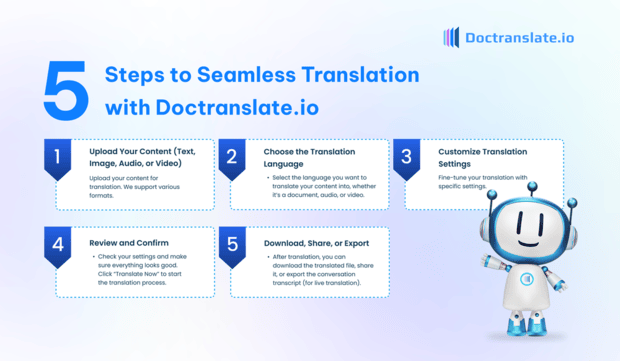Introduction
In today’s globalized world, translating emails is crucial for effective communication across different linguistic communities. Whether you need to communicate with international clients, partners, or team members, overcoming language barriers is essential.
Email translation ensures your message is accurately conveyed and understood, regardless of the recipient’s native language. Doctranslate offers a streamlined solution to translate your emails efficiently and accurately.
Doctranslate simplifies the translation process, making it accessible to everyone. It allows you to translate documents, text, images, audio, and videos, ensuring seamless communication in any format.
This guide will demonstrate how to translate your emails from English to Chinese (Traditional) using Doctranslate. You’ll learn the simple steps to achieve accurate and professional email translations, expanding your reach and enhancing your global interactions.
Step-by-Step Guide: Translating Email from English to Chinese (Traditional) with Doctranslate.io
Step 1: Upload Your Content
Start by uploading your email document to Doctranslate.
You can easily upload your email in various formats, including:
- DOCX
- PPTX
- XLSX
Translate Document feature supports these formats, ensuring a smooth upload process for your email translation needs. Simply select your file and upload it to begin.
Step 2: Choose the Translation Language
After uploading your email, the next step is to select the target language for translation.
For this guide, we aim to translate from English to Chinese (Traditional).
Doctranslate supports a wide array of languages, making it versatile for various translation requirements. Choose ‘Chinese (Traditional)’ as your desired output language to proceed.
Step 3: Customize Your Translation Settings
Doctranslate allows you to customize your translation to meet specific needs.
Enhance your email translation by using these customization options:
- Select the desired tone for your translation, ensuring it aligns with your communication style.
- Choose a domain to refine the translation accuracy based on the email’s subject matter.
- Utilize My Dictionary to further fine-tune specific terms and ensure consistent terminology.
These features help you tailor the translation, making it more accurate and contextually relevant. Customize Document Translation to get the best results.
Step 4: Review and Confirm
Before initiating the translation, it’s important to review your settings. Double-check that you’ve selected English as the original language and Chinese (Traditional) as the target language.
Ensure your customization preferences, such as tone and domain, are correctly set.
Once you are satisfied with your settings, proceed by clicking the ‘Translate Now’ button. This action will send your email for translation based on your specified preferences.
Step 5: Download, Share, or Export
Once Doctranslate completes the translation, your translated email is ready for download.
You can download the translated document directly to your device, making it easy to access and share.
Doctranslate ensures that the formatting of your original document is preserved in the translated version, maintaining clarity and professionalism.

Conclusion
Translating Email from English to Chinese (Traditional) is now straightforward with Doctranslate. By following these five simple steps, you can effectively translate your emails and communicate with a broader audience.
Doctranslate’s user-friendly interface and customization options ensure accurate and contextually appropriate translations. Start leveraging the power of seamless communication today.
Whether it’s documents, text, images, audio, or video, Doctranslate provides a comprehensive suite of translation tools to meet all your needs.
Don’t let language barriers limit your reach. Visit Doctranslate.io today and experience the ease of global communication!


Leave a Reply